Comparing the Performance of Pivotless Tracking and Fixed-Type Floating Solar Power Systems
Abstract
:1. Introduction
2. Materials and Methods
3. Results and Discussion
4. Conclusions
Author Contributions
Funding
Institutional Review Board Statement
Informed Consent Statement
Data Availability Statement
Conflicts of Interest
References
- Zheng, H.; Song, M.; Shen, Z. The evolution of renewable energy and its impact on carbon reduction in China. Energy 2021, 237, 121639. [Google Scholar] [CrossRef]
- Smirnova, E.; Kot, S.; Kolpak, E.; Shestak, V. Governmental support and renewable energy production: A cross-country review. Energy 2021, 230, 120903. [Google Scholar] [CrossRef]
- Wang, Q.; Dong, Z.; Li, R.; Wang, L. Renewable energy and economic growth: New insight from country risks. Energy 2022, 238, 122018. [Google Scholar] [CrossRef]
- Salameh, T.; Sayed, E.T.; Abdelkareem, A.; Olabi, A.G.; Rezk, H. Optimal selection and management of hybrid renewable energy System: Neom city as a case study. Energy Convers. Manag. 2021, 244, 114434. [Google Scholar] [CrossRef]
- Opeyemi, B.M. Path to sustainable energy consumption: The possibility of substituting renewable energy for non-renewable energy. Energy 2021, 228, 120519. [Google Scholar] [CrossRef]
- Sharma, G.D.; Shah, M.I.; Shahzad, U.; Jain, M.; Chopra, R. Exploring the nexus between agriculture and greenhouse gas emissions in BIMSTEC region: The role of renewable energy and human capital as moderators. J. Environ. Manag. 2021, 297, 113316. [Google Scholar] [CrossRef] [PubMed]
- Mohsin, M.; Kamran, H.W.; Nawaz, M.A.; Hussain, M.S.; Dahri, A.S. Assessing the impact of transition from nonrenewable to renewable energy consumption on economic growth-environmental nexus from developing Asian economies. J. Environ. Manag. 2021, 284, 111999. [Google Scholar] [CrossRef] [PubMed]
- Jeffry, L.; Ong, M.Y.; Nomanbhay, S.; Mofijur, M.; Mubashir, M.; Show, P.L. Greenhouse gases utilization: A review. Fuel 2021, 301, 121017. [Google Scholar] [CrossRef]
- Dong, K.; Dong, X.; Jiang, Q.; Zhao, J. Assessing energy resilience and its greenhouse effect: A global perspective. Energy Econ. 2021, 104, 105659. [Google Scholar] [CrossRef]
- Chahidi, L.Q.; Fossa, M.; Priarone, A.; Mechaqrane, A. Energy saving strategies in sustainable greenhouse cultivation in the mediterranean climate–A case study. Appl. Energy 2021, 282, 116156. [Google Scholar] [CrossRef]
- Singh, D.; Chaudhary, R.; Karthick, A. Review on the progress of building-applied/integrated photovoltaic system. Environ. Sci. Pollut. Res. 2021, 28, 47689–47724. [Google Scholar] [CrossRef] [PubMed]
- Ahmed, S.; Mekhilef, S.; Mubin, M.B.; Tey, K.S. Performances of the adaptive conventional maximum power point tracking algorithms for solar photovoltaic system. Sustain. Energy Technol. Assess. 2022, 53, 102390. [Google Scholar] [CrossRef]
- Prasad, A.R.; Shankar, R.; Patil, C.K.; Karthick, A.; Kumar, A.; Rahim, R. Performance enhancement of solar photovoltaic system for roof top garden. Environ. Sci. Pollut. Res. 2021, 28, 50017–50027. [Google Scholar] [CrossRef]
- Marion, B. Measured and satellite-derived albedo data for estimating bifacial photovoltaic system performance. Sol. Energy 2021, 215, 321–327. [Google Scholar] [CrossRef]
- Plessis, A.A.; Strauss, J.M.; Rix, A.J. Short-term solar power forecasting: Investigating the ability of deep learning models to capture low-level utility-scale Photovoltaic system behaviour. Appl. Energy 2021, 285, 116395. [Google Scholar] [CrossRef]
- Rahman, M.M.; Hasanuzzaman, M.; Rahim, N.A. Effects of various parameters on PV-module power and efficiency. Energy Convers Manag. 2015, 103, 348–358. [Google Scholar] [CrossRef]
- Kumar, P.; John, S.S.; Shukla, A.K.; Sudhakar, K.; Arbind, K. Performance analysis of 68W flexible solar PV. J. Energy Res. Environ. Technol. 2015, 2, 227–231. [Google Scholar]
- Sudhakar, K.; Srivastava, T. Energy and energy analysis of 36W solar photovoltaic module. Int. J. Ambient Energy 2013, 2, 31–34. [Google Scholar]
- Kumar, B.S.; Sudhakar, K. Performance evaluation of 10 MW grid connected solar photovoltaic power plant in India. Energy Rep. 2015, 1, 184–192. [Google Scholar] [CrossRef] [Green Version]
- Gotmare, J.A.; Prayagi, S.V. Enhancing the performance of photovoltaic panels by stationary cooling. Int. J. Sci. Eng. Technol. 2014, 2, 1465–1468. [Google Scholar]
- Shukla, K.N.; Rangnekar, S.; Sudhakar, K.A. Comparative study of exergetic performance of amorphous and polycrystalline solar PV modules. Int. J. Exergy 2015, 17, 433–455. [Google Scholar] [CrossRef]
- Salamah, T.; Ramahi, A.; Alamara, K.; Juaidi, A.; Abdallah, R.; Abdelkareem, M.A.; Amer, E.; Olabi, A.G. Effect of dust and methods of cleaning on the performance of solar PV module for different climate regions: Comprehensive review. Sci. Total Environ. 2022, 827, 154050. [Google Scholar] [CrossRef] [PubMed]
- Agyekum, E.B.; Praveen Kumar, S.; Alwan, N.T.; Velkin, V.I.; Shcheklein, S.E.; Yaqoob, S.J. Experimental Investigation of the Effect of a Combination of Active and Passive Cooling Mechanism on the Thermal Characteristics and Efficiency of Solar PV Module. Inventions 2021, 6, 63. [Google Scholar] [CrossRef]
- Verma, S.; Mohapatra, S.; Chowdhury, S.; Dwivedi, G. Cooling techniques of the PV module: A review. Mater. Today Proc. 2021, 38, 253–258. [Google Scholar] [CrossRef]
- Moore, S.; Hackett, E.J. The construction of technology and place: Concentrating solar power conflicts in the United States. Energy Res. Soc. Sci. 2016, 11, 67–78. [Google Scholar] [CrossRef]
- Ehtiwesh, I.A.S.; Coelho, M.C.; Sousa, A.C.M. Exergetic and environmental life cycle assessment analysis of concentrated solar power plants. Renew. Sustain. Energy Rev. 2016, 56, 145–155. [Google Scholar] [CrossRef]
- Manente, G.; Rech, S.; Lazzaretto, A. Optimum choice and placement of concentrating solar power technologies in integrated solar combined cycle systems. Renew. Energy 2016, 96, 172–189. [Google Scholar] [CrossRef]
- An, S.; Woo, J. Comparative Economic Analysis of RE100 Implementation Methods in South Korea. Curr. Photovolt. Res. 2020, 10, 62–71. [Google Scholar]
- Hardy, J.; Sandry, L. Anticipating customer-centred zero-carbon energy business models. Nat. Energy 2022, 7, 383–385. [Google Scholar] [CrossRef]
- Chien, F.; Ngo, Q.; Hsu, C.; Chau, K.Y.; Mohsin, M. Assessing the capacity of renewable power production for green energy system: A way forward towards zero carbon electrification. Environ. Sci. Pollut. Res. 2021, 28, 65960–65973. [Google Scholar] [CrossRef]
- Cazzaniga, R.; Rosa-Clot, M. The booming of floating PV. Sol. Energy 2021, 219, 3–10. [Google Scholar] [CrossRef]
- Kwon, O.; Kwon, J.; Jo, H.; Cha, H. The Deduction of Generation Efficiency Coefficient of the Floating PV systems with the Cooling Effect of Water Surface. Korean Inst. Electr. Eng. 2020, 69, 1364–1370. [Google Scholar]
- Kwon, O.; Jo, H.; Cho, Y.; Kwon, J.; Kim, S.; Cha, H. Experimental Verification of the Efficiency Increase of Floating PV with Water Surface Reflection. In Proceedings of the KIEE Summer Conference, Goseong-gun, Republic of Korea, 2–4 July 2019; pp. 1222–1223. [Google Scholar]
- Kwon, T.; Kim, J.; Kim, E.; Hong, S. Effect on Power Generation of Floating Photovoltaic Power System Power by Water Level Change. J. Korean Sol. Energy 2022, 42, 13–21. [Google Scholar] [CrossRef]
- Awasthi, A.; Shukla, A.K.; Manohar, M.; Dondariya, C.; Shukla, K.N.; Porwal, D.; Richhariya, G. Review on sun tracking technology in solar PV system. Energy Rep. 2020, 6, 392–405. [Google Scholar] [CrossRef]
- Nisar, H.; Janjua, A.K.; Hafeez, H.; Shakir, S.; Shahzad, N.; Waqas, A. Thermal and electrical performance of solar floating PV system compared to on-ground PV system-an experimental investigation. Sol. Energy 2022, 241, 231–247. [Google Scholar] [CrossRef]
- Sulaeman, S.; Brown, E.; Quispe-Abad, R.; Muller, N. Floating PV system as an alternative pathway to the amazon dam underproduction. Renew. Sust. Energy. Rev. 2021, 135, 110082. [Google Scholar] [CrossRef]
- Hammoumi, A.E.; Chalh, A.; Allouhi, A.; Motahhir, S.; Ghzizal, A.E.; Derouich, A. Design and construction of a test bench to investigate the potential of floating PV systems. J. Clean. Prod. 2021, 278, 123917. [Google Scholar] [CrossRef]
- Dass Tech. Available online: http://www.dasstech.com/products/solar-inverters/on-grid-residential/dass-3-0i-2/ (accessed on 7 December 2022).
- Davis. Available online: https://www.davisinstruments.com/pages/vantage-pro2 (accessed on 7 December 2022).
- Solaris. Available online: https://www.solaris-shop.com/hanwha-q-cells-q-peak-duo-blk-g5-310-310w-mono-solar-panel/ (accessed on 7 December 2022).
- Ismail, M.A.; Ramanathan, K.; Idris, M.H.; Ananda-Rao, K.; Mazlan, M.; Fairuz, N. Improving the performance of solar panels by the used of dual axis solar tracking system with mirror reflection. J. Phys. Conf. Ser. 2020, 1432, 012060. [Google Scholar] [CrossRef]
- D’Agostino, D.; Minelli, F.; D’Urso, M.; Minichiello, F. Fixed and tracking PV systems for Net Zero Energy Buildings: Comparison between yearly and monthly energy balance. Renew. Energy 2022, 195, 809–824. [Google Scholar] [CrossRef]
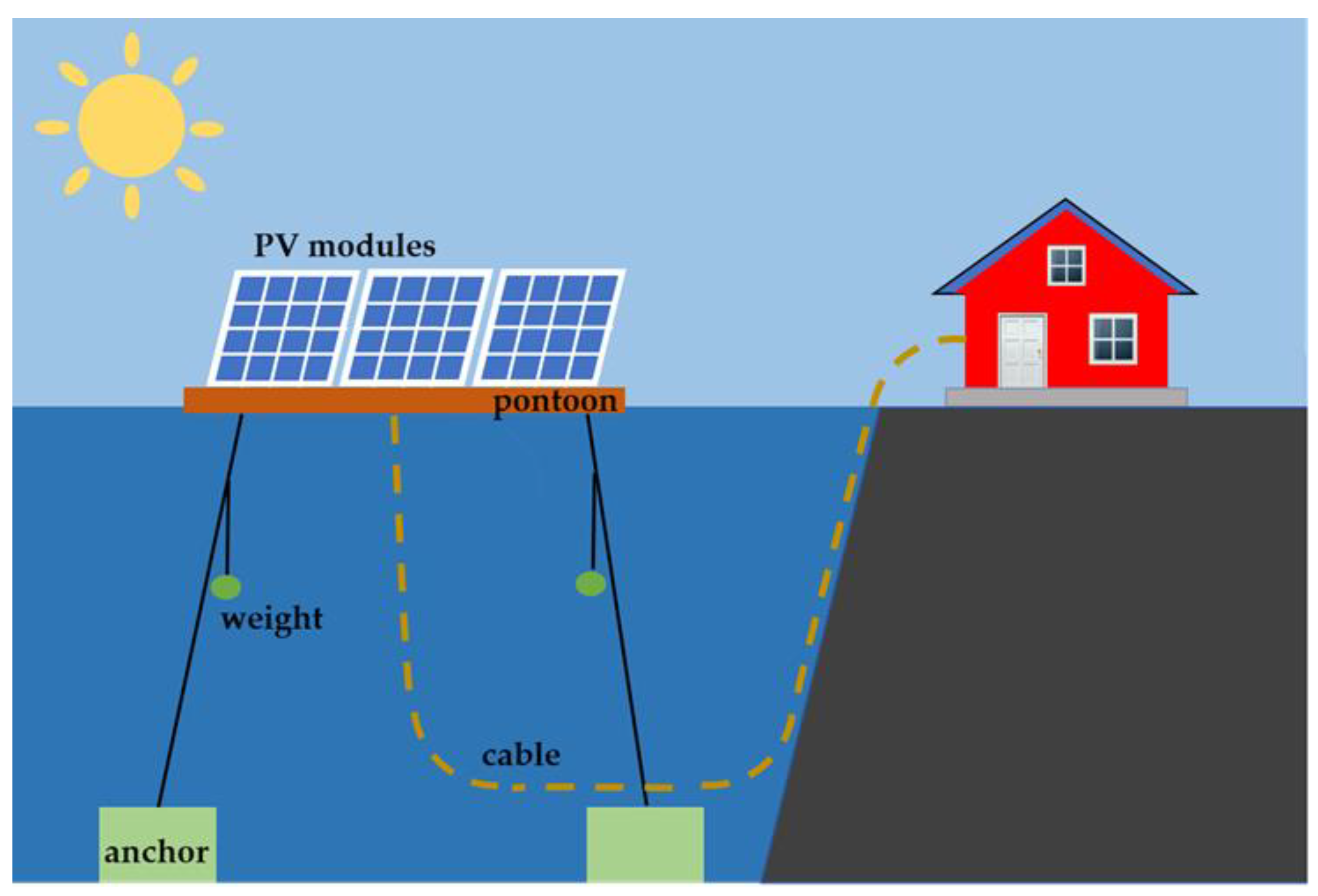

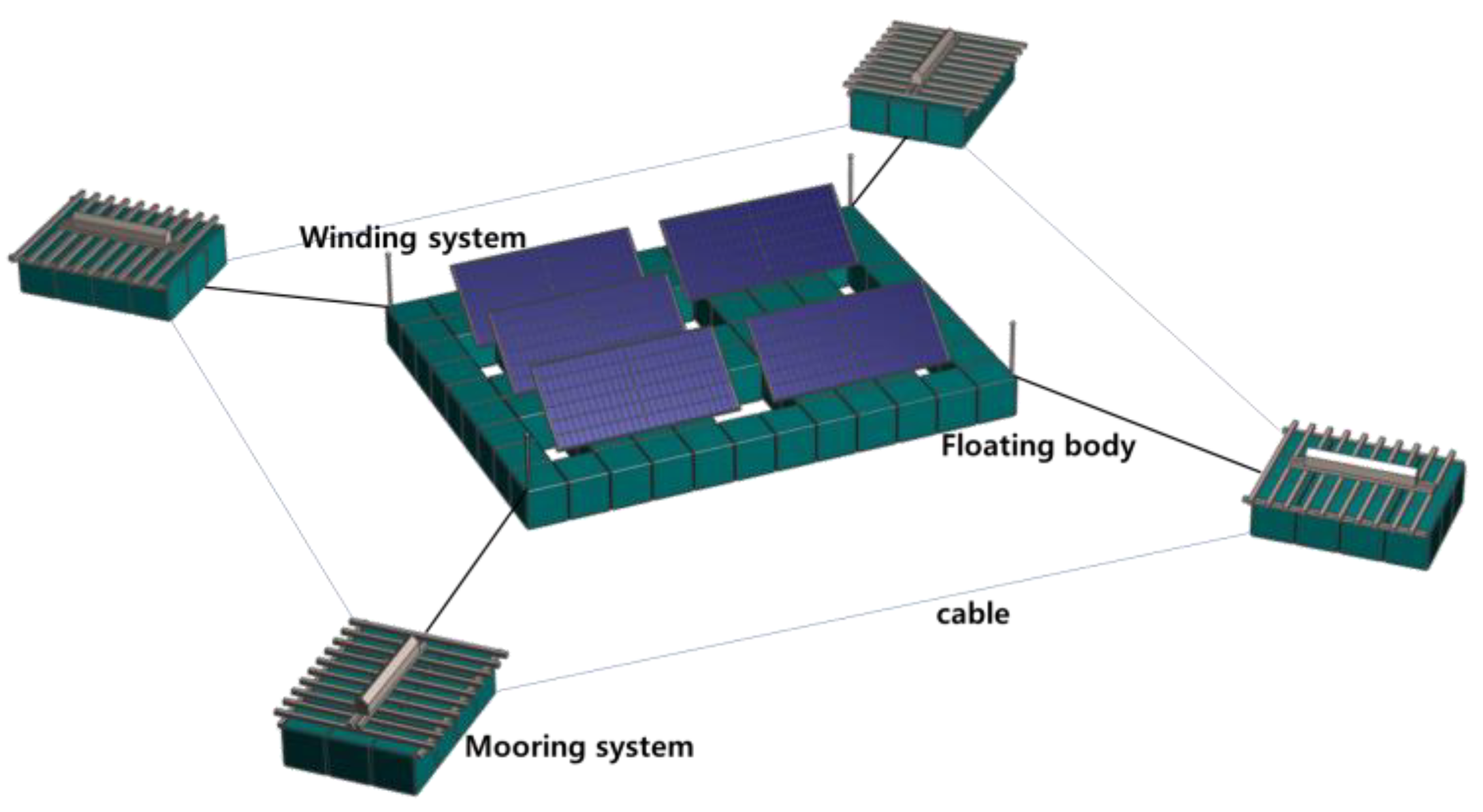
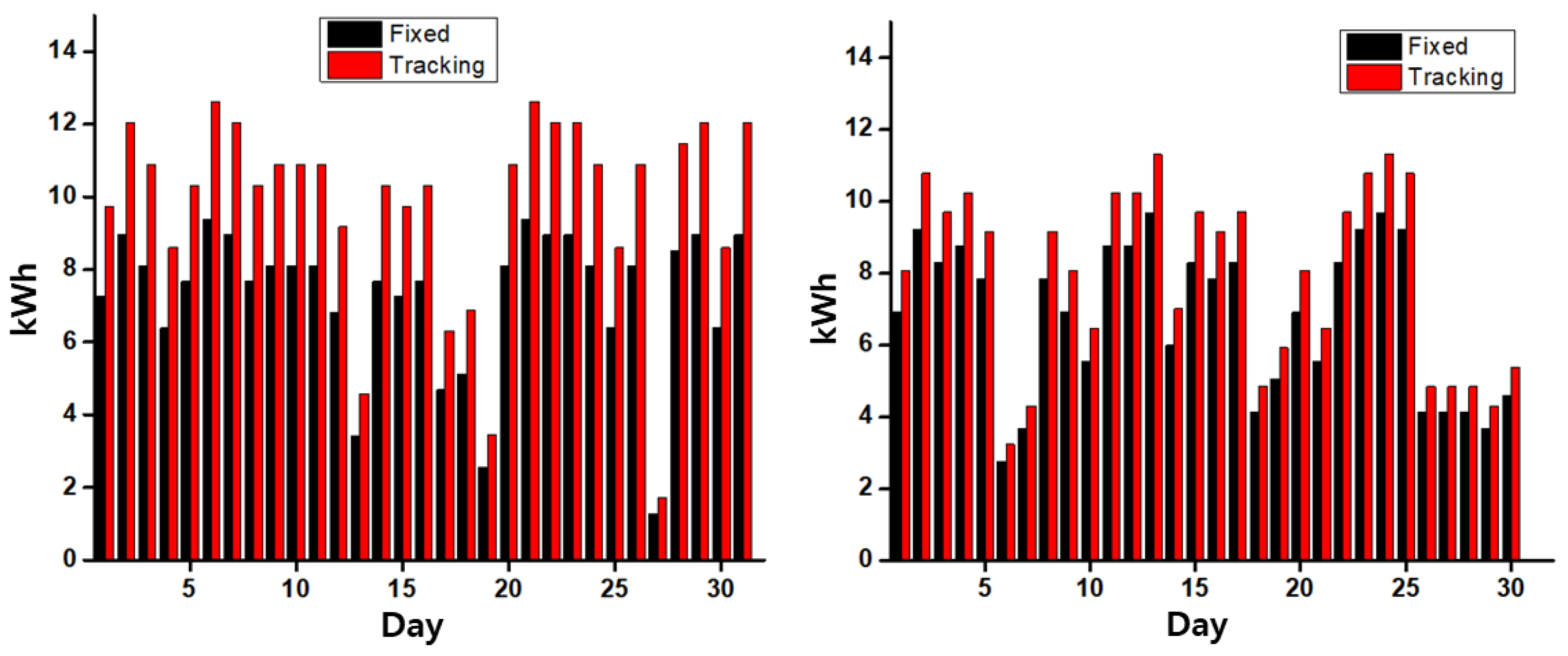




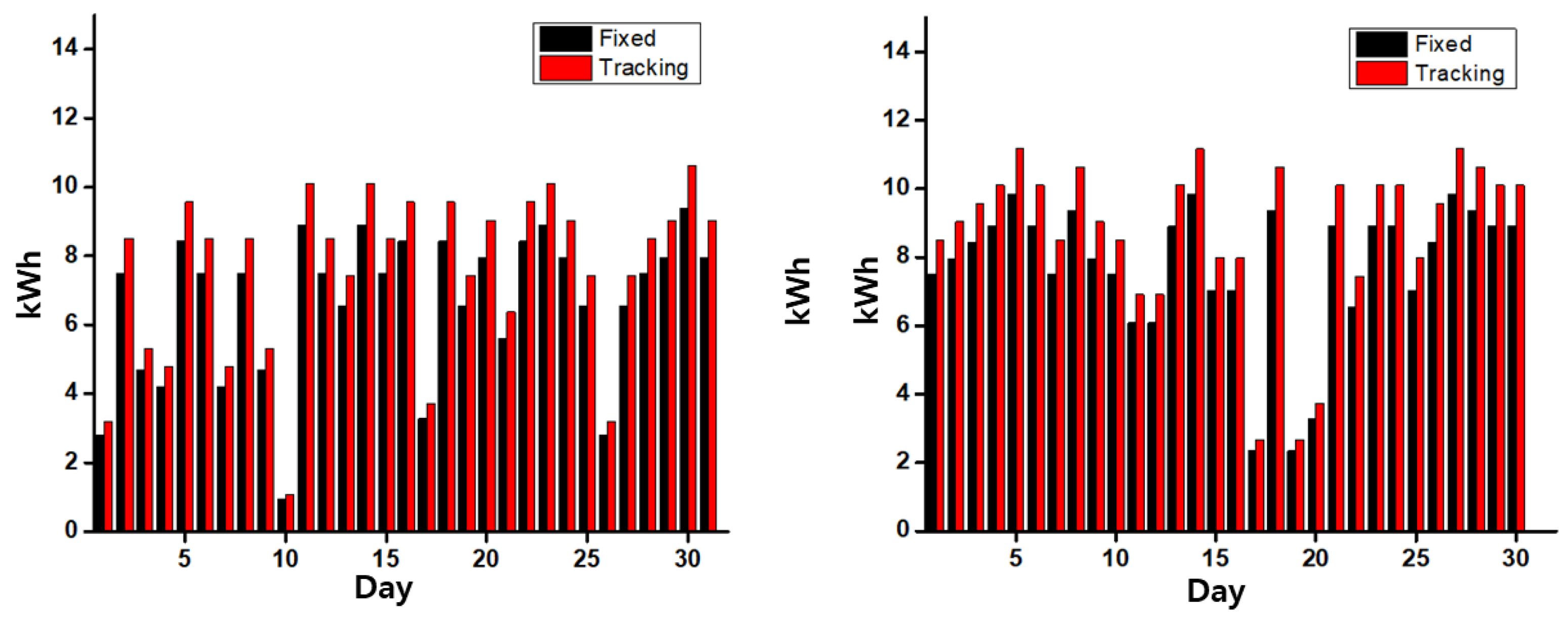

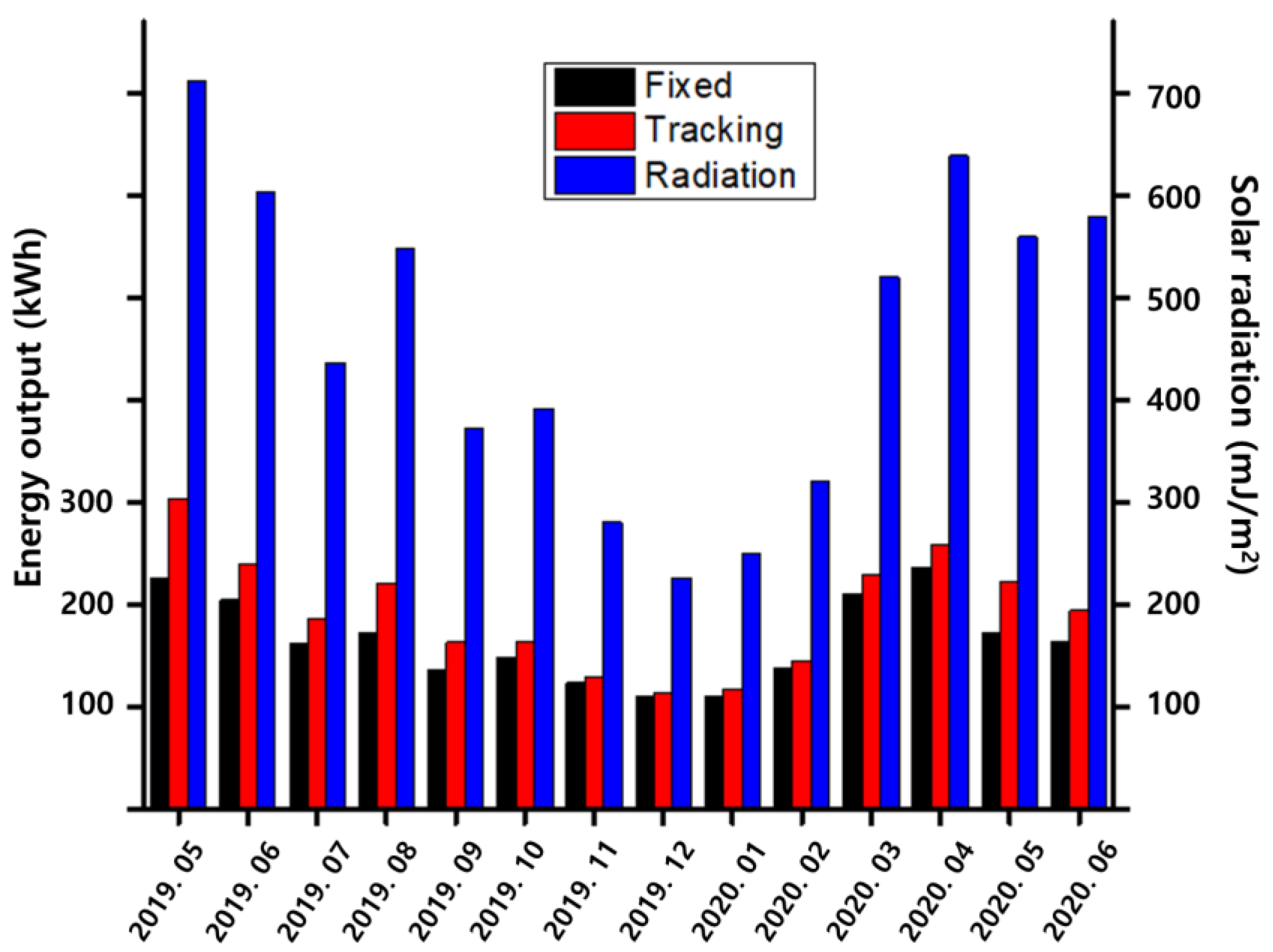
| Type | Fixed (kWh) | Tracking (kWh) | Increased Rate (%) |
|---|---|---|---|
| Total energy output | 2313.30 | 2684.69 | 13.83 |
Publisher’s Note: MDPI stays neutral with regard to jurisdictional claims in published maps and institutional affiliations. |
© 2022 by the authors. Licensee MDPI, Basel, Switzerland. This article is an open access article distributed under the terms and conditions of the Creative Commons Attribution (CC BY) license (https://creativecommons.org/licenses/by/4.0/).
Share and Cite
Jee, H.; Noh, Y.; Kim, M.; Lee, J. Comparing the Performance of Pivotless Tracking and Fixed-Type Floating Solar Power Systems. Appl. Sci. 2022, 12, 12926. https://doi.org/10.3390/app122412926
Jee H, Noh Y, Kim M, Lee J. Comparing the Performance of Pivotless Tracking and Fixed-Type Floating Solar Power Systems. Applied Sciences. 2022; 12(24):12926. https://doi.org/10.3390/app122412926
Chicago/Turabian StyleJee, Hongsub, Yohan Noh, Minwoo Kim, and Jaehyeong Lee. 2022. "Comparing the Performance of Pivotless Tracking and Fixed-Type Floating Solar Power Systems" Applied Sciences 12, no. 24: 12926. https://doi.org/10.3390/app122412926
APA StyleJee, H., Noh, Y., Kim, M., & Lee, J. (2022). Comparing the Performance of Pivotless Tracking and Fixed-Type Floating Solar Power Systems. Applied Sciences, 12(24), 12926. https://doi.org/10.3390/app122412926








